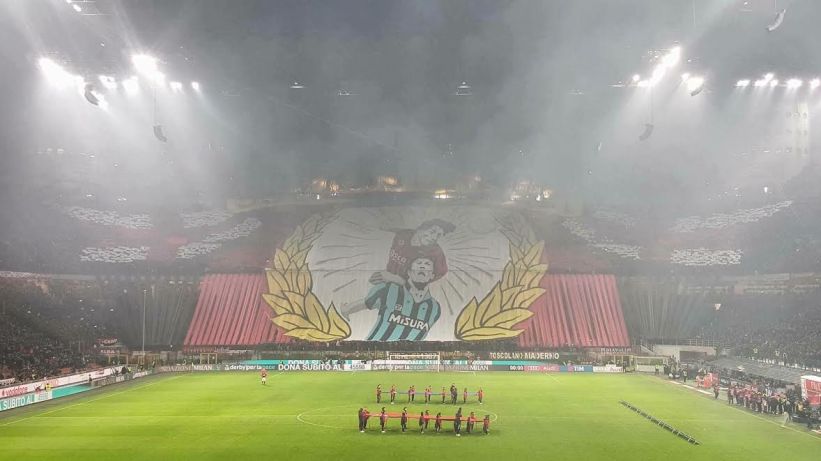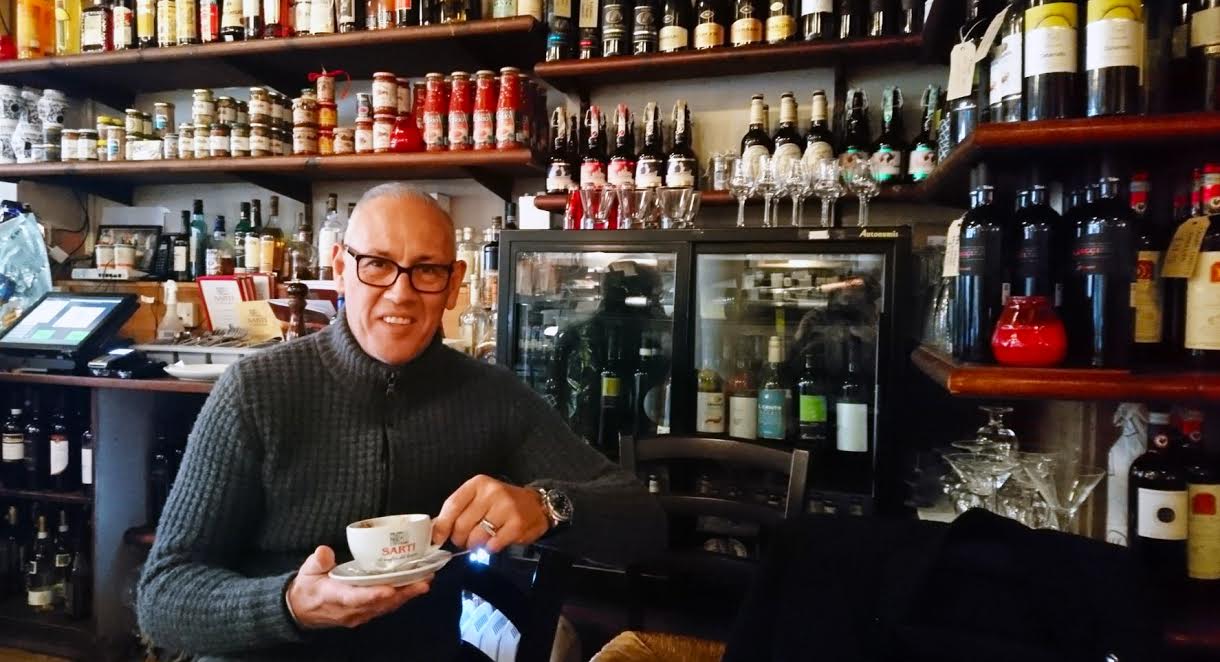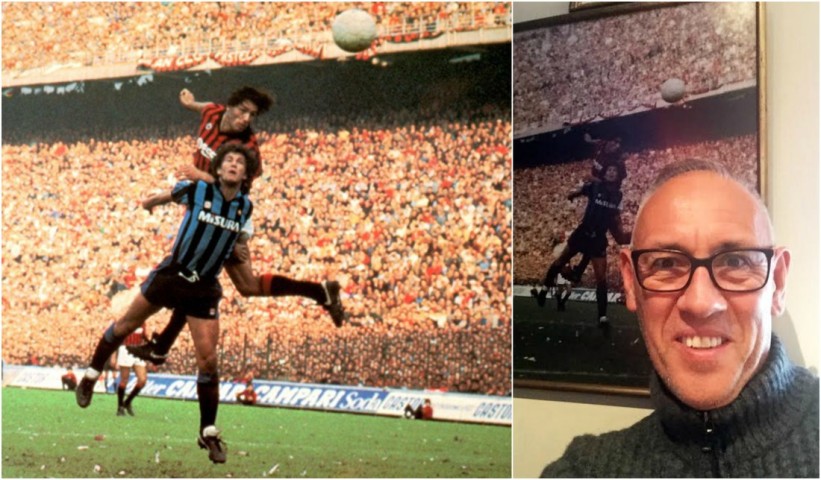I will never forget the first time I saw Stadio San Siro. Reaching the top of those famous winding steps, the pitch and its imposing four walls of noise, colour and smoke opening up in front of you; it’s a sight to behold.
Being a spectator at this footballing cathedral is special enough; so how must it feel to score a winning goal in the Milan derby? Luckily for Englishman Mark Hateley, it’s a question he can answer. “It was an incredible feeling,” Hateley told The Gentleman Ultra in an exclusive interview. “When you’re young, the significance of goals doesn’t really sink in… the enormity of the derby goal sank in almost straight away, though.”
It was late October 1984, and the goal in question was AC Milan’s second in a 2-1 victory over rivals Inter. With 25 minutes of the match remaining and the game finely poised at a goal apiece, Hateley rose majestically to meet Pietro Paolo Virdis’ cross from the right wing – towering over Fulvio Collovati (formerly of AC Milan) – and sent a header crashing past the despairing Walter Zenga in the Inter goal. The winning goal was extra sweet for the red and black half of Milan, as it ended a barren spell of six seasons without a win against their much-lauded rivals, albeit two of those seasons were spent, even more embarrassingly for the Rossoneri, in Serie B.
So, just how did a 22-year-old Englishman, who spent the 1983/84 season plying his trade in English football’s second tier with Portsmouth, end up scoring the winning goal in the Derby della Madonnina?
A total of 25 goals in 44 appearances for Pompey saw Hateley called up to the England Under-21 squad for the 1984 European Championships – and so began a whirlwind summer that led to the striker’s move from England’s south coast to Italy’s fashion capital. A four-goal salvo from Hateley in a 6-1 English victory over France in the quarter-finals elevated the young striker’s standing in the game, and the senior team’s manager, Bobby Robson, was clearly taking note. Another goal in the 2-0 victory over Spain in the final was all Robson needed to see – Hateley was on the plane for the full squad’s tour of South America that summer. The magic didn’t stop there, however. In one of English football’s finest hours, Hateley scored in a 2-0 win against Brazil in the iconic Maracana stadium, a victory that also included a wonderful solo goal from John Barnes. European football’s biggest clubs were on alert.
“The morning after the Brazil game, Ray Wilkins [who had already agreed to join AC Milan from Manchester United] asked me if I’d like to come and play with him at AC Milan,” Hateley said. “Being young and naïve, I thought ‘there’s no way Portsmouth will let me leave my contract’, but, within a week, I’d signed for AC Milan.”
The attacker revealed that the influence of his father, Tony – also a striker – meant there was no way he could let the opportunity of joining AC Milan pass him by. “I always wanted to be the best player I could be,” he said. “The driving force behind this was my dad being a footballer. He played for some big clubs, and I wanted to go on and be a better player than him.”
Far from being the finished article, Hateley admitted that the process of ‘deconstructing’ his game began as soon as he made his first steps on Milan’s training pitch. Although impressed with the Englishman’s ability, it was clear from the outset that changes would have to be made to adapt Hateley’s traditionally British style of play with the technicalities and tactics of Italian football. As Hateley himself explained, “in England, it was run, run, run, tackle, tackle, tackle, whereas Italian football is very, very tactical – everyone has a job to do within the machine.”
A memory from the striker’s childhood gives a valuable insight into his style of play in those early days of his professional career. “I never had a bike until my last year of school,” he said. “I had to run everywhere. My dad would say ‘if you want to be a footballer, you’ll thank me for it.’ My pals all had bikes, but for me it was run, run, run, run. I could run all day. This was something very unusual in Italy as Italian strikers aren’t runners.”
Key to this process of ‘deconstructing’ the Englishman’s game was Fabio Capello, who, at that time, managed Milan’s Primavera team, and would go on to become one of the greatest football coaches of all time. “On many afternoons, Fabio Capello would bring a goalkeeper, me, a bag of balls and a million cones out on to the training pitches,” Hateley recalled. “Capello would tell me ‘we don’t want you to tackle full-backs’… he would deconstruct my game and build it back up again.”
Hateley was similarly impressed with first team coach, the Swede Nils Liedholm. During his playing career, Liedholm had formed part of a much revered, all Swedish, AC Milan strike force alongside Gunnar Gren and Gunnar Nordahl – or ‘Gre-No-Li’ as they became known. Hateley’s arrival at Milan coincided with the beginning of Liedholm’s third spell in charge of the Rossoneri and Hateley quickly sought to learn from his Mister’s expertise:
As an ex-centre forward himself, Nils Leidholm was the perfect manager for me. He played in the 1958 World Cup, scoring against Pele and Brazil in the final. It was ideal for me. We spent so much time just talking.
In Hateley’s own words, he made a ‘crash, bang, wallop’ start to his time in Italy. The crowds on the Peninsula hadn’t seen a player like this before. “In the pre-season games, they were likening me to a tornado,” he said. “I would go on the pitch and cause devastation wherever I went.” His rugged style saw Hateley sent off for violent conduct in one of his earliest matches for Milan, but his work on the training ground – under the expert tutelage of Liedholm and Capello – didn’t take long to bear fruit: Hateley scored four goals in six games as Milan made an unbeaten start to the 1984/85 Serie A campaign.Thus, Milan went into October’s derby with Inter – who had Irishman Liam Brady and marquee summer signing Karl-Heinz Rummenigge in their ranks – high in confidence. A picture of Hateley’s winning goal that day takes pride of place in his study at home, near Glasgow. Recalling the post-match feeling of derby day success, Hateley said:
There was such a reaction to everything that was happening around me. There were sponsorship deals for boots, clothes, cars – they all started coming to me from that day. I thought, ‘I’ve done something massive here.’
Mark Hateley standing proud next to the framed picture of his iconic derby goal against Inter
Hateley was making his mark on Italian football at the perfect time. Players such as Mauro Tassotti, Alessandro Costacurta and a 16-year-old Paolo Maldini were plying their trade at AC Milan, while the likes of Rummenigge at Inter, Socrates (Fiorentina), Michel Platini (Juventus) and Maradona (Napoli) ensured that record Serie A crowds were getting value for money. “I was a 22-year-old lad playing in the best league in the world in front of the biggest crowds in European football, it was all just surreal,” Hateley admitted. The Englishman also enjoyed the privilege of starring in a team led by Franco Baresi, who Hateley refers to as ‘a great captain, a great guy…a great human being.’
Hateley’s terrific start to the 84/85 campaign was interrupted when he suffered a knee injury in a match against Juventus. Interestingly, as he underwent surgery, the room beside Hateley’s was occupied by the man who could not reach the Englishman’s iconic derby winning header, the Inter goalkeeper, Zenga.
The flamboyant shot-stopper had suffered a similar injury to Hateley, but their respective reactions to the resultant surgery were somewhat different. “I remember Zenga being in the other room screaming,” Hateley recalled. “So I got up out my bed and went through to see him on my crutches and said ‘what’s happening? What’s going on in here?’ He is such a great character. I still see him a lot when I’m out covering football in the Middle East and we always have a good laugh.”
Thankfully, Hateley recovered from the injury and regained his place in Milan’s starting XI. The Englishman played both legs of the Coppa Italia final that first season in Italy, which Milan lost 3-1 on aggregate to a Graeme Souness-inspired Sampdoria. Scotsman Souness scored the only goal in the Blucherchiati’s 1-0 first-leg victory. “He reminds me of that whenever we meet!” Hateley said.
The Englishman spent another two seasons with the Rossoneri, who finished the Serie A standings fifth, seventh and fifth respectively in Hateley’s three seasons at the club. With Silvio Berlusconi arriving as Milan’s president in 1986 – and wasting no time in announcing his recruitment policy for the summer of 1987 – Hateley described his final season at the club as somewhat ‘difficult.’ “There was a big noise and all the chat that he [Berlusconi] was going to be bringing in [Marco] Van Basten, [Frank] Rijkaard and [Ruud] Gullit as his three foreigners,” Hateley remembers.
This was announced in the summer before my last season so I knew I would be leaving. I had a whole season of knowing that I wouldn’t be kept on, which didn’t go down well with the supporters, who I had a great relationship with. This was a really difficult period for me. I was being named to play every game and then a message would come in on match day to say that I wasn’t playing. Berlusconi was trying to phase me out.
Despite not winning any major trophies in his three-year spell at Milan, Hateley earned something arguably more important: he won the hearts of the Milan fans and the right to be recognised as a ‘bandiera’ for the club. This special relationship with the fans was cultivated by Hateley’s style as a player.“I was a fans’ player, a fan who just wanted to play the game,” he said. Such players – those who supporters can see are out on the park playing with passion, desire and heart for their club – are greatly revered in Italy. Such is Hateley’s status among Rossoneri fans, his iconic leap above Collovati in that ’84 derby was the subject of the Milan curva’s ‘tifo’ display ahead of the January 2016 Derby della Madonnia, which Hateley’s old side went on to win 3-0. “It was incredible to see the display,” he said. “It’s something that will live with me forever.”

Click to read Mark ‘Attila Hateley’: AC Milan’s Derby Day Hero
Following his three years in Milan, Hateley went on to play for Monaco before enjoying a trophy-laden five years with Glasgow Rangers. His time in Italy is still a period he looks back on with much fondness, though. “I had an absolutely fantastic time in Milan,” he said. And judging by his relationship with the Milan fans, and their subsequent curva display, they had an absolutely fantastic time watching the Englishman wear the famous red and black jersey.
Words by Martin Dunlop: @Dunlop8
Many thanks to Mark Hateley for taking time out of his busy schedule, and to Rangers F.C. for their help in contacting Mark.


